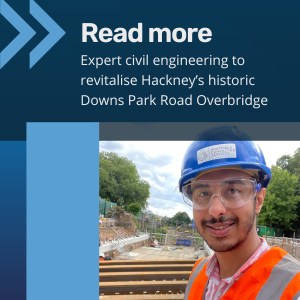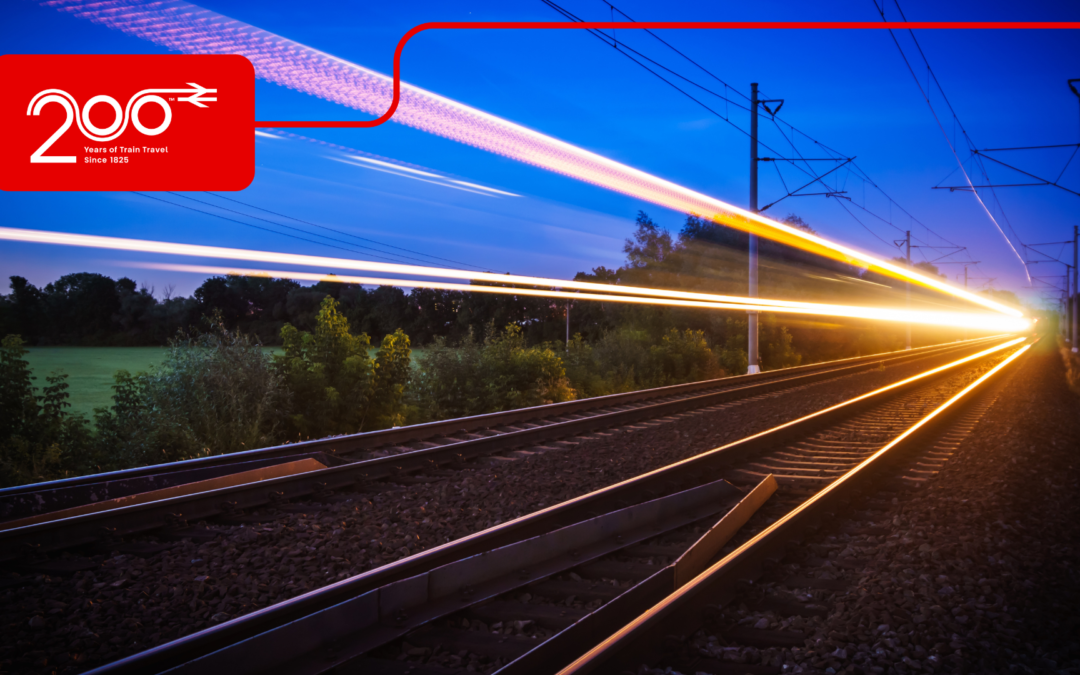200 years ago, the world was changed by the opening of the first railway in Britain. The pioneering spirit that shaped the early railways still lives on today, as the industry and government work toward achieving zero-emission rail transport and more efficient, accessible networks.
As the industry gears up to celebrate this remarkable anniversary, we gathered some of our rail engineering specialists – Nick Lowe, Asa Whitfield, Chris Beattie, and Jeremy Barnes – to share their predictions for the future of rail and highlight how civil engineering will continue to underpin the development of this vital transport network.
Chris Beattie, Principal Civil Engineer: A railway powered by renewable energy, transformed by technology
Chris envisions a railway powered by renewable energy and transformed by advanced technology. Drawing inspiration from his ancestor Joseph Hamilton Beattie, a 19th-century locomotive engineer, he reflects on the parallels between past and present advancements: “In the mid-19th century, my ancestor pioneered cleaner, more efficient steam engines. Today, rail must undergo a similar transformation for the zero-emission age.”
Taking us on a journey into the future, he says: “Fast-forward 200 years from today, and all trains have been zero-emission for over 175 years, powered by solar, wind, and battery technology. AI and automation ensure driverless trains operate safely, and carriages can separate and join in motion, cutting journey times and increasing direct services.”
He also imagines a future where passengers enjoy greater comfort and convenience: “Long-distance trains are now double-decker, with all seating equivalent to first-class comfort. Food and drink are delivered by robot trolleys, and passengers are directed to their reserved seats via smartphones.”
For Chris, the decline of aviation due to carbon emissions opens the door to a new era of international rail travel: “Sleeper-pod trains will have become the norm for overnight journeys from the UK to European cities, transforming how we travel across borders and reducing our reliance on short-haul flights.”
Jeremy Barnes, Technical Director: Maximising existing infrastructure with AI and drones
Jeremy believes the future of rail is bright, with passenger numbers anticipated to rise. “With Great Britain such a congested island, we have seen that constructing new rail infrastructure can be problematic, making it increasingly important to maximise the usage of our existing assets. Providing an effective, reliable, and efficient railway system will be essential for future economic growth.”
Technology will play a key role in this transformation. “Currently, knowledge of our railway assets is inconsistent, and the cost of obtaining up-to-date condition information can be significant. However, as technology advances, these costs will drop. Drone technology, coupled with AI, will allow for easier assessment of asset conditions. Further developments in non-intrusive techniques will provide more accurate data collection on previously hidden elements, such as foundations.”
According to Jeremy, digital twins of all rail assets will soon be developed, allowing real-time condition monitoring and predictive maintenance. “With more accurate data, we can develop targeted repair and strengthening strategies. Patterns and trends in asset deterioration will be identified, factoring in the effects of climate change, allowing early interventions to prevent costly repairs later on. This approach will ensure a more sustainable and cost-effective railway network.”
Asa Whitfield, Managing Director: Railways to reconnect communities, driven by sustainability
For Asa, the future of rail lies in reconnecting communities and embracing sustainable technologies. He believes reinstating lost rail connections is crucial for our communities and the development of net-zero transport:
“A dedicated fund and political momentum should be introduced to reinstate lost rail connections, like the Dartmoor Line and Borders Rail. These projects would reconnect people, while also providing opportunities to utilise sustainable technologies like battery and hydrogen-powered trains.”
He also highlights the importance of extending high-speed rail to better connect the UK and beyond: “High-speed rail must extend north to Scotland. It’s also time to de-monopolise cross-channel services and consider a second tunnel. This would allow through-trains from Scotland and the north of England directly to cities across Europe, significantly reducing the need for short-haul flights.”
Nick Lowe, Director: A reliable and affordable railway, built for the future
For Nick, the future of rail must focus on reliability and affordability, making train travel a practical choice for more people. “If we want rail to be the backbone of transport in the future, we need to get the basics right. People will choose rail if it works for them – if it’s affordable, dependable, and convenient. Ticket prices must be competitive with the cost of driving, and services must provide unwavering reliability.”
He also highlights the need for investment in infrastructure to support long-term reliability: “Maintaining and upgrading the existing network is just as important as new lines and connections. We need to ensure that every part of the railway – from rural branch lines to major intercity routes – is resilient and future-proof.”
Shaping the future of rail
WCS is at the forefront of rail infrastructure development, delivering projects that address the demands of modern rail. Notable projects include the £1.5 billion modernisation of the Midland Main Line and the £2.9 billion Piccadilly Line upgrade.
“The upgrading, electrification, and expansion of rail networks require highly specialised skills to address complex technical and logistical challenges,” says Asa. “Civil engineering is at the heart of these efforts, ensuring that both new lines and ageing infrastructure are designed and constructed to meet the needs of the present and future rail transport system.”
“Working with the right civil engineering experts is key to overcoming these challenges and delivering robust and sustainable infrastructure for generations to come.”
Read our booklet, Delivering the UK and Republic of Ireland’s rail ambitions through civil engineering expertise to learn how our team is supporting the transformation of the UK and Republic of Ireland’s rail networks. Or, to learn why specialist Small and Medium Enterprises (SMEs) are ideally placed to deliver CP7 success, read our article here.
For expert guidance and support on your rail projects, contact WCS to learn how we can help implement civil engineering solutions that meet your goals. Get in touch.
Learn more about the Railway 200 celebrations and how you can get involved here:

